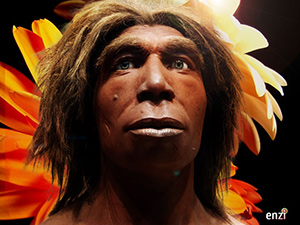Re-creating a Hominin
 Once fossils are prepared and preserved, the bones are assembled and a detailed drawing or reconstruction is made of the remains. Experts are then used to recreate the possible physical appearance of the hominin.
Once fossils are prepared and preserved, the bones are assembled and a detailed drawing or reconstruction is made of the remains. Experts are then used to recreate the possible physical appearance of the hominin.
In most cases, a nearly complete skull is required to reconstruct facial features and a partial skeleton, especially with some limb bones, is needed to recreate height, body build and possible movement capabilities (leg bones essentially carry a skeleton so looking at the length, size and strength of these bones provides clues as to how a hominin moved).
However, for fragile or incomplete remains, particularly skulls, CT scans (computerised tomography) can help create a virtual 3D image and then a plastic cast.
The skull
To reconstruct a complete skull, the missing parts can be filled with modelling clay. On some specimens the reconstruction of missing parts is a simple task that can be achieved by copying the features from one side of the body to the other. The task becomes more complex when an individual is missing an entire feature, such as the jaw or both cheek bones. In this case, it may be possible to copy the feature from other individuals of the same species. Otherwise, scientists have to rely on a detailed knowledge of anatomy to determine the appropriate shape and size of the missing feature.
Once the skull is re-created soft tissues, muscles and other tissues such as nose cartilage, fat deposits and the eyes can be added to flesh out the head. The general size and shape of the nose can be worked out using the structure of the surrounding bones as well as the size and shape of the nasal opening. However, the exact details of the nose will remain unknown. The correct eye colour is also debatable.
The body
Muscles, tendons, fat tissues and skin are then added to recreate a ‘living’ hominin. Fleshing out a skull or skeleton helps give a better understanding of how they looked and moved. Experts use marks on fossil bones to help them reattach soft tissues, as these reveal where the tissues attached and how bulky the muscles were. They use educated guesses based on dissections of primates and forensic anthropology techniques, particularly for determining the thickness of tissues.
Skin and hair are added to complete the reconstruction but these are often the most debatable aspects. Our ancestors’ skin colour and degree of hairiness is determined by comparisons with modern humans and other living primates.
